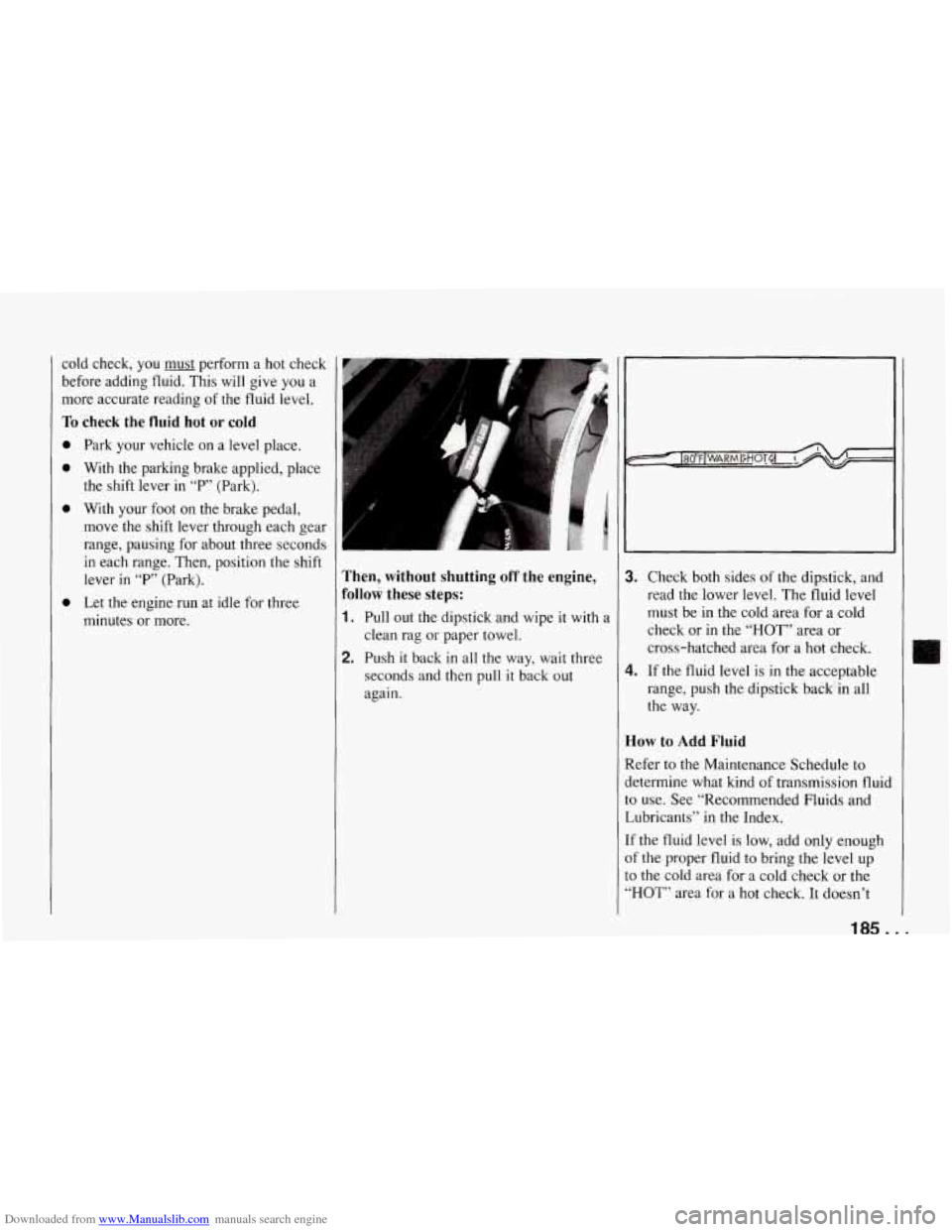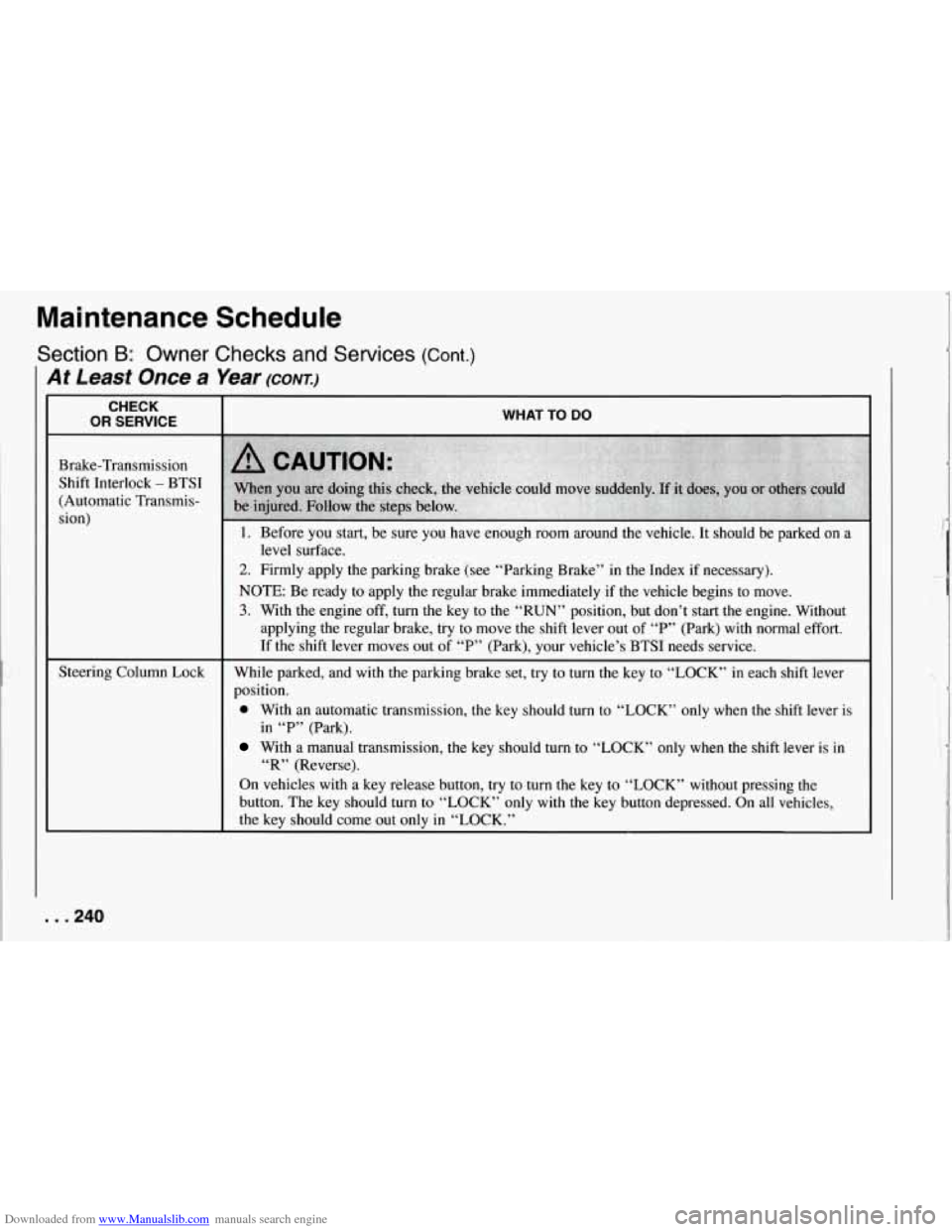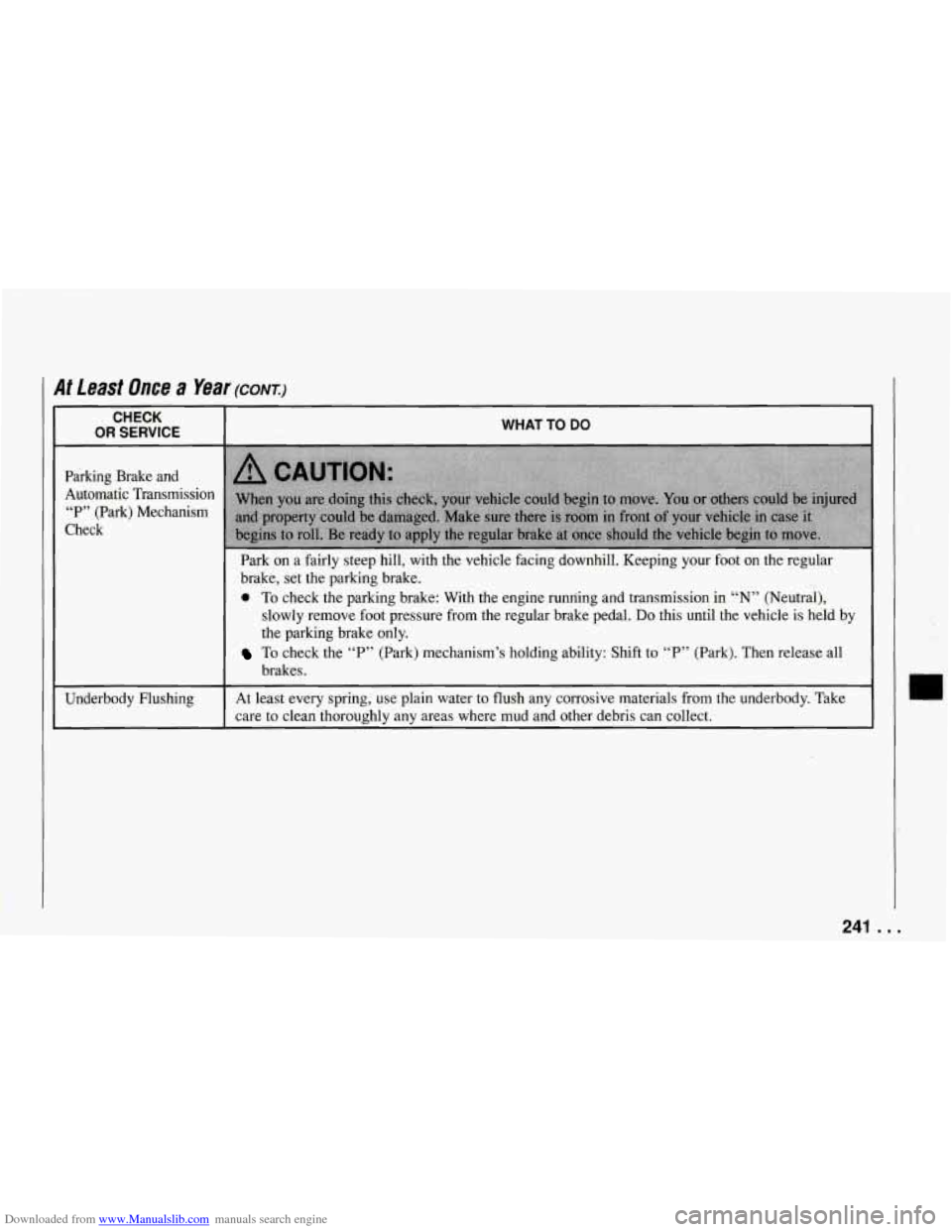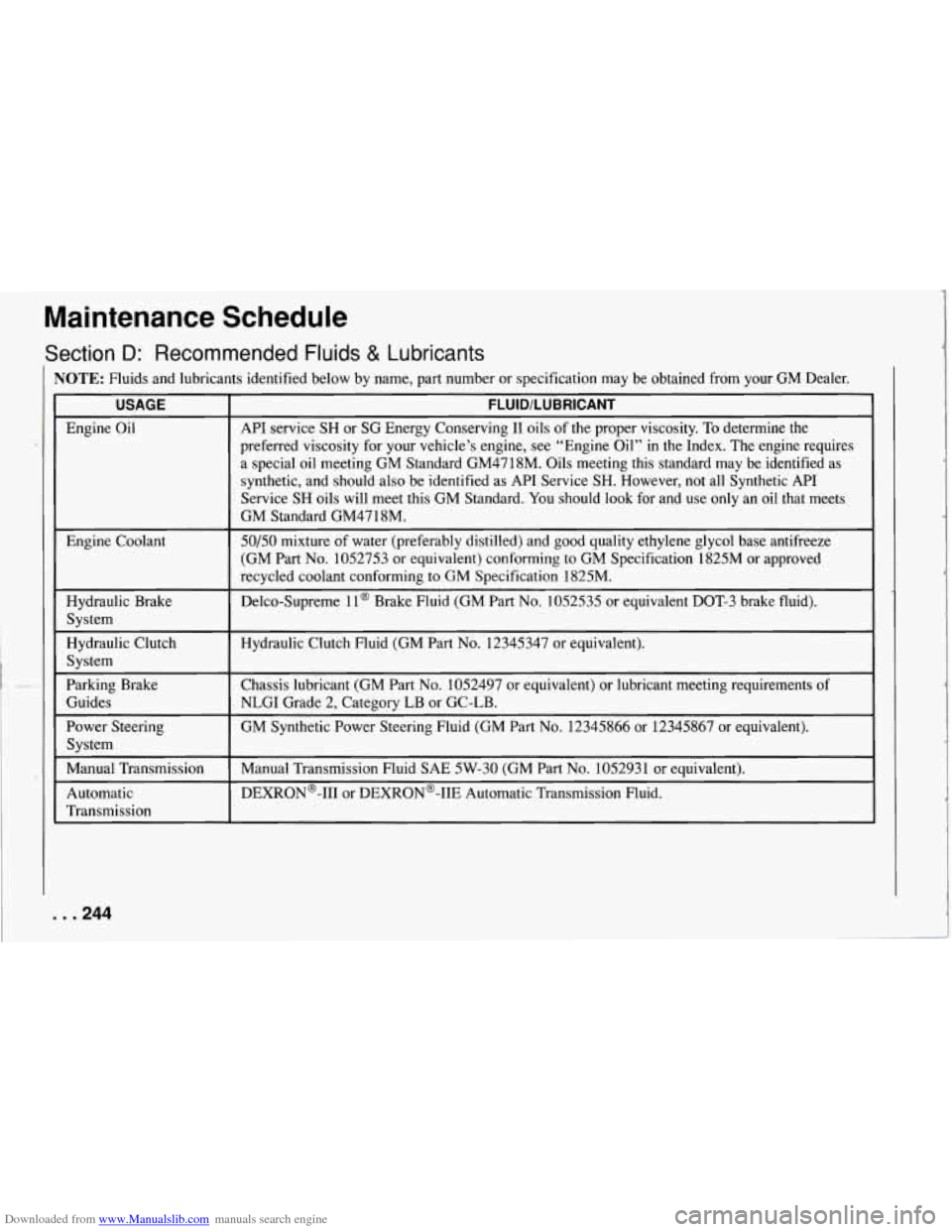1994 CHEVROLET CORVETTE parking brake
[x] Cancel search: parking brakePage 186 of 274

Downloaded from www.Manualslib.com manuals search engine cold check, you must perform a hot check
before adding fluid. This will give you a
more accurate reading
of the fluid level.
To check the fluid hot or cold
0
Park your vehicle on a level place.
With the parking brake applied, place
the shift lever in “P” (Park).
With your foot
on the brake pedal,
move the shift lever through each gear
range, pausing for about three seconds
in each range. Then, position the shift
lever
in “P’ (Park).
Let the engine run at idle for three
minutes or more. Then, without shutting off the engine,
Follow these steps:
1. Pull out the dipstick and wipe it with a
clean rag or paper towel.
2. Push it back in all the way, wait three
seconds and then pull
it back out
again.
3. Check both sides of the dipstick, and
read the lower level. The fluid level
must be in the cold area for a cold
check or in the
“HOT” area or
cross-hatched area for a hot check.
range, push the dipstick back in all
the way.
4. If the fluid level is in the acceptable
How to Add Fluid
Refer to the Maintenance Schedule to
determine what kind of transmission fluid to use. See “Recommended Fluids and
Lubricants” in the Index.
If the fluid level
is low, add only enough
of the proper fluid to bring the level up
to the cold area for a cold check or the
“HOT” area for a hot check. It doesn’t
Page 237 of 274

Downloaded from www.Manualslib.com manuals search engine Maintenance Schedule
C L Section A: Scheduled Maintenance Services (Cont.)
Explanation of Scheduled
Maintenance Services
Following are explanations of the services
listed in Schedule I and Schedule
11.
The proper fluids and lubricants to use are
listed in Section D. Make sure whoever
services your vehicle uses these. All parts
should be replaced and all necessary
repairs done before you or anyone else
drives the vehicle.
NOTE: To determine your engine’s
displacement and code, see
“Engine Identification” in the
Index.
ITEM
NO. SERVICE
1 Engine Oil and Filter Change* -
Always use SH or SG Energy
Conserving I1 oils of proper
viscosity. The engine requires a
special oil meeting GM Standard
GM4718M. Oils meeting this
Standard may be identified as
synthetic, and should also be
identified as API Service
SH or
SG. However, not all Synthetic
API Service
SH oils will meet
ITEM
NO. SERVICE
this GM Standard. You should
look for and use only an oil that
meets GM Standard GM4718M.
To determine the preferred
viscosity for your vehicle’s
engine (e.g.,
SAE 5W-30 or SAE
10W-30), see “Engine Oil” in
the Index.
Your vehicle has an Engine Oil
Life Monitor. This monitor will
show you when to change the oil
- usually between 3,000 miles
(5 000 km) and 7,500 miles
( 12 500 km) since your last oil
change. Under severe conditions
the indicator may come on before
3,000 miles
(5 000 km). Never
drive your vehicle more than
7,500 miles (12
500 km) or 12
months without an oil change.
The system won’t detect dust in
the oil..
So if you drive in a dusty
area be sure
to change your oil
every 3,000 miles
(5 000 km) or
sooner if the “Change Oil” light
comes on.
ITEM
NO.
2
3
4
SERVICE
Remember to reset the Oil Life
Monitor when the oil has been
changed. For more information, see “Engine Oil Life Monitor”
in the Index.
Chassis Lubrication
- Lubricate
suspension and steering linkage.
Lubricate the transmission shift
linkage, and parking brake cable guides, underbody contact points
and linkage.
Engine Accessory Drive Belt(s) Inspection
- Inspect the belt(s)
for cracks, fraying, wear and
proper tension. Replace as needed. (Belts can have many
small cracks in individual ribs
without affecting performance.)
Cooling System Service*
-
Drain, flush and refill the system with
new or approved recycled
coolant conforming to GM
Specification 1825M. Keep
coolant at the proper mixture as
specified. See “Coolant” in the
* An Emission Control Service.
. . .236
Page 240 of 274

Downloaded from www.Manualslib.com manuals search engine I At Least Once a Year
WHAT TO DO
Lubricate the key lock cylinders with the lubricant specified in Section D.
Lubricate all body door hinges. Also lubricate all hinges and latches, including those for the hood,
rear compartment, glove box door, console door and any folding seat hardware. Section
D tells
you what to use.
1. Before you start, be sure you have enough room around the vehicle.
2. Firmly apply both the parking brake (see “Parking Brake” in the Index if necessary) and the
regular brake.
....
NOTE: Do not use the accelerator pedal, and be ready to turn off the engine immediately if it
starts.
3. On automatic transmission vehicles, try to start the engine in each gear. The starter should
work only in
“P” (Park) or “N” (Neutral). If the starter works in any other position, your
vehicle heeds service.
On manual transmission vehicles, put the shift lever in “N” (Neutral), push the clutch down
halfway and try to start the engine. The starter should work only when the clutch is pushed
down all the way to the floor. If the starter works when the clutch isn’t pushed all the way
down, your vehicle needs service.
r::. ,; II
U
239. . .
Page 241 of 274

Downloaded from www.Manualslib.com manuals search engine At Least Once a Year (CONT.)
CHECK
OR SERVICE
Brake-Transmission Shift Interlock
- BTSI
(Automatic Transmis-
sion)
Maintenance Schedule
Section B: Owner Checks and Services (Cont.)
Steering Column Lock
WHAT TO DO
1. Before you start, be sure you have enough room around the vehicle. It should be parked on a
2. Firmly apply the parking brake (see “Parking Brake” in the Index if necessary).
NOTE: Be ready to apply the regular brake immediately if the vehicle begins to move.
3. With the engine off, turn the key to the “RUN” position, but don’t start the engine. Without
applying the regular brake, try to move the shift lever out of “P” (Park) with normal effort.
If the shift lever moves out of “P” (Park), your vehicle’s BTSI needs service.
level surface.
While parked, and with the parking brake set,
try to turn the key to “LOCK” in each shift lever
position.
0 With an automatic transmission, the key should turn to “LOCK” only when the shift lever is
With a manual transmission, the key should turn to “LOCK” only when the shift lever is in
On vehicles with a key release button, try to turn the key to “LOCK” without pressing the
button. The key should turn to. “LOCK” only with the key button depressed. On all vehicles,
the key should come out only in “LOCK.”
in
“P” (Park).
“R” (Reverse).
. . .240
Page 242 of 274

Downloaded from www.Manualslib.com manuals search engine I At Least Once a Year (CONI)
CHECK
OR SERVICE ~~ ~
Parking Brake and
Automatic Transmission “P” (Park) Mechanism
Check
Underbody Flushing
WHAT TO DO
Park on a fairly steep hill, with the vehicle facing downhill. Keeping \
your foot on the regular
brake, set the parking brake.
0 To check the parking brake: With the engine runriing and transmission in “N” (Neutral),
slowly remove foot pressure from the regular brake pedal.
Do this until the vehicle is held by
the parking brake only.
brakes.
To check the “P” (Park) mechanism’s holding ability: Shift to “P” (Park). Then release all
At least every spring, use plain water to flush any corrosive mat\
erials from the underbody. Take
care to clean thoroughly any areas where mud and other debris can collect. I I
241 . . .
Page 244 of 274

Downloaded from www.Manualslib.com manuals search engine INSPECTION
OR SERVICE
I WHAT SHOULD BE DONE
Manual Transmission
Inspect the complete system. Inspect brake lines and hoses for proper hookup, binding, leaks,
Brake System Check the gear lubricant level in the rear axle and add
if needed. See “Rear Axle” in the Index.
Rear Axle Service Check the transmission fluid level;
add if needed. See “Manual Transmission” in the Index.
Inspection cracks, chafing, etc. Inspect disc brake pads
for wear and rotors for surface condition. Inspect
A fluid loss may indicate a problem. Check the system and rep\
air
if needed.
A fluid loss may indicate a problem. Check the axle and repair it
if needed.
other brake parts, including calipers, parking brake, etc. You may need to have your brakes
inspected more often if your driving habits or conditions result in frequent braking.
NOTE: A low brake fluid level can indicate worn disc brake pads whi\
ch may need to be
serviced. Also, if the brake system warning light stays on or comes on, something may be
wrong with the brake system. See “Brake System Warning Light” in the Index.
If your anti-lock
brake system warning light stays on or comes on, something may be wrong with the anti-lock
brake system. See
“ Anti-Lock Brake System Warning Light” in the Index.
I 1
243. . .
Page 245 of 274

Downloaded from www.Manualslib.com manuals search engine Maintenance Schedule
Section D: Recommended Fluids & Lubricants
NOTE: Fluids and lubricants identified below by name, part number or specification may be obtained from your GM Dealer.
USAGE FLUID/LUBRICANT
Engine Oil
API service SH or SG Energy Conserving I1 oils of the proper viscosity. To determine the
preferred viscosity for your vehicle’s engine, see “Engine Oil” in the Index. The engine requires
a special oil meeting GM Standard GM4718M. Oils meeting this stan\
dard may be identified as
synthetic, and should also be identified as API Service SH. However, not all Synthetic API
Service SH oils will meet this GM Standard.
You should look for and use only an oil that meets
GM Standard GM4718M.
Engine Coolant
50/50 mixture of water (preferably distilled) and good quality ethylene glycol base antifreeze
(GM Part No. 1052753 or equivalent) conforming to GM Specification 1825M or approved
recycled coolant conforming to GM Specification 1825M.
Hydraulic Brake Delco-Supreme
ll@ Brake Fluid (GM Part No. 1052535 or equivalent DOT-3 brake fluid).
System
Hydraulic Clutch System Hydraulic Clutch Fluid
(GM Part No. 12345347 or equivalent).
Parking Brake
Chassis lubricant (GM Part No. 1052497 or equivalent) or lubricant meeting requirements of
Guides NLGI Grade 2, Category LB or GC-LB.
Power Steering
GM Synthetic Power Steering Fluid (GM Part
No. 12345866 or 12345867 or equivalent).
System
Manual Transmission
Transmission DEXRON@-I11 or
DEXRON@-IIE Automatic Transmission Fluid.
Automatic Manual Transmission Fluid
SAE 5W-30 (GM Part
No. 1052931 or equivalent).
. . .244
Page 262 of 274

Downloaded from www.Manualslib.com manuals search engine ABS ........................ 125
Acceleration Slip Regulation
System
..................... 126
Accessory Plug
.................. 76
Acrylic Roof Panel
............... 70
Adding Coolant
................ 189
Add-on Electrical Equipment
..... 21 8
Air Bag System ................. 23
How the System Works
......... 24
Servicing Your Air Bag-
Equipped Corvette
........... 26
Readiness Light
................ 24
Air Cleaner
.................... 182
Air Conditioner Controls
......... 106
Air Control Buttons
............. 106
Air Filter Replacement
........... 183
Alignment and Tire Balance. Wheel
. 208
Aluminum Wheels
.............. 2 15
AMPM Stereo
With Cassette Tape Player
...... 11 3
With Cassette Tape and
Compact Disc Player
........ 11 5
Antenna. Power Mast. Care
....... 11 8
Anti-Lock Brakes
.............. ‘125
System Active Light
............ 86
System Warning Light
.......... 85
To Use
..................... 126
Appearance Care
............... 21 0
Appearance Care and Materials .... 21 7
Appearance Care. Service and
..... 171 Ashtray and
Lighter
.............. 75
ASR System
................... 126
Active Light
.................. 87
Off Light .................... 86
Warning Light
................ 86
Audio Systems
................. 112
Audio Systems. Comfort Controls and
................. 105
Automatic Electronic Climate
Control
..................... 108
Air Control Buttons
........... 108
Automatic Control
............ 109
Defogging and Defrosting
Windows
................. 110
Fan
Control Buttons ........... 108
Manual Bi-Level
............. 109
Manual Cooling
.............. 109
-Manual Heating
.............. 109
Manual Ventilation
............ 109
System Problems
............. 110
Temperature Control Switch .... 108
Temperature Sensors
.......... 108
Automatic Transmission
.......... 5 1
Automatic Transmission Fluid
..... 184
Axle. Limited-Slip Rear
........... 56
Axle. Rear
.................... 188
Babies. Smaller Children
Balance. Wheel Alignment and
(Safety Belts)
.............. 28
and Tire
.................... 208 Battery
....................... 195
Battery Replacement. Passive Keyless
Entry System
................. 41
BBB Auto Line
. Alternative
Dispute Resolution Program.
GM Participation in
......... 253
Before Leaving on a Long Trip
.... 135
Belt. Lap-Shoulder
............... 20
Bi-Level
...................... 107
Blizzard. If You’re Caught in a
.... 138
Block Heater. Engine
............. 50
Brakes Adjustment
.................. 194
Anti-Lock (ABS)
............. 125
Fluid
....................... 193
Master Cylinder
.............. 193
Parking
...................... 56
PedalTravel
................. 194
System Parts. Replacing
........ 194
System Warning Light
.......... 84
Wear Indicators. Disc
.......... 194
Braking (Control of a Vehicle)
..... 124
Braking in Emergencies
.......... 127
“Break.In.
.. New Vehicle ......... 46
Brightness Control
............... 67
Bulb Replacement
.............. 195
Back-up Light
............... 198
Center High-Mounted Stoplight
.............. 200. 201
Cornering Light
.............. 199
Fog Lamp
................... 196
261 ...